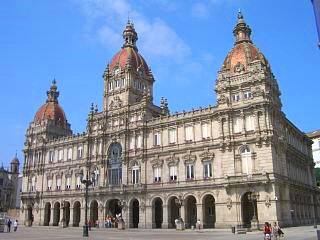The Maria Pita square
The Maria Pita square is probably A Coruna's main city plaza and takes its name from the town's heroine, Maria Pita. below is a shot of some of the terraced buildings that suround the plaza, with galerias at the top level.

Maria Pita herself came to notoriety as a result of her role in Sir Francis Drake's attack on A Coruna in 1589 and she is credited with playing a critical part in reducing the losses of the Corunans during this assault. A new cultural museum in A Coruna has sections celebrating Pita's life and also acts to illuminate the period during which she lived. I believe that her house may also be part of the exhibit, but am happy to be corrected on that fact!
The square or plaza to which Pita gives her name is grand to say the least. The main entrance (which you approach from the city's harbour side) is distinguished and gives the impression that you are walking into a Royal court.
 This impression is further enhanced by the Town Hall and Council building (Palacio Municipal) which is truly monumental in both its scale and incredibly ornate detailing. The photo of this building (left) really does not do it justice and the three domed towers at its front are topped with what appears to be bronze as it glistens in the sun. This building also has a long colonnaded archway traversing its main facade and completely dominates the large square. Its appearance does however suggest a greater age than the structure really lays claim to – it was actually built in the early 20th century and is less than 100 years old. In addition to various chambers and meeting rooms, the Palacio Municipal contains a clock museum.
This impression is further enhanced by the Town Hall and Council building (Palacio Municipal) which is truly monumental in both its scale and incredibly ornate detailing. The photo of this building (left) really does not do it justice and the three domed towers at its front are topped with what appears to be bronze as it glistens in the sun. This building also has a long colonnaded archway traversing its main facade and completely dominates the large square. Its appearance does however suggest a greater age than the structure really lays claim to – it was actually built in the early 20th century and is less than 100 years old. In addition to various chambers and meeting rooms, the Palacio Municipal contains a clock museum.
Below, a close of the Palacio Municipal showing some of the detailed masonry work that the building displays.
 After the initial awe of the City Hall, the other buildings surrounding the Maria Pita plaza are, whilst not disappointing, slightly less grandiose. That said, many are typical examples of the best of la Coruna's architecture and include galerias and the region's main building component of granite. All these buildings are either interconnected, or in very close proximity to one another giving the square an enclosed, but still light and airy feel. Unlike some of Galicia's other plazas, the Maria Pita square offers attractive facades in all four directions and had all the tourists actively making use of their cameras and videos whilst we were there.
After the initial awe of the City Hall, the other buildings surrounding the Maria Pita plaza are, whilst not disappointing, slightly less grandiose. That said, many are typical examples of the best of la Coruna's architecture and include galerias and the region's main building component of granite. All these buildings are either interconnected, or in very close proximity to one another giving the square an enclosed, but still light and airy feel. Unlike some of Galicia's other plazas, the Maria Pita square offers attractive facades in all four directions and had all the tourists actively making use of their cameras and videos whilst we were there.
Also in this plaza is a statue to its "name-sake" heroine and several bars and restaurants, plus one of A Coruna's tourist information points (at the opposite end to the Council offices). At the time of our visit, the square was also being used for festival concerts and was decked out with a large stage and lighting rig. Both Santiago de Compostela and A Coruna manage to attract major artists and musicians as performers in their main fiesta events.
Iglesia de San Jorge
Although not in the Maria Pita square itself, the square does offer a view of the small but
 elegant church of St. George (Iglesia de San Jorge), which you reach by exiting the plaza to the left of the Palacio Municipal. This church was built in the eighteenth century and is in the typical baroque style of that period. It has a slender and almost elongated appearance with two bell towers and also has the addition of an elaborate cruceiro in the small courtyard in front of it. It was designed by Architect Domingo de Andrade.
elegant church of St. George (Iglesia de San Jorge), which you reach by exiting the plaza to the left of the Palacio Municipal. This church was built in the eighteenth century and is in the typical baroque style of that period. It has a slender and almost elongated appearance with two bell towers and also has the addition of an elaborate cruceiro in the small courtyard in front of it. It was designed by Architect Domingo de Andrade.
Right, a photo of the church of Saint George just outside the Pita square.
Back to the A Coruna main page.

